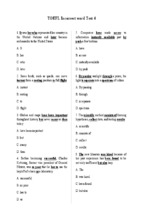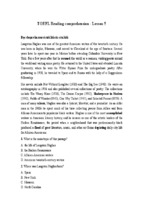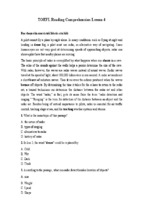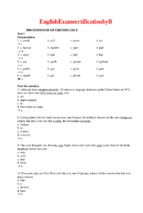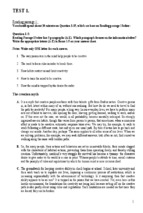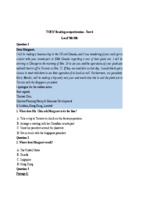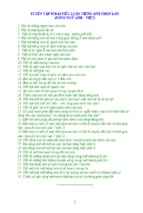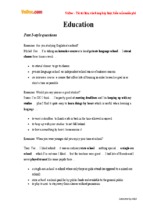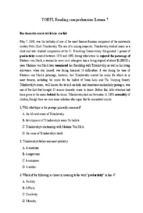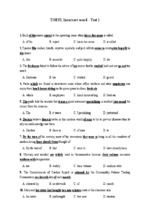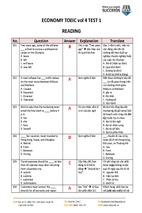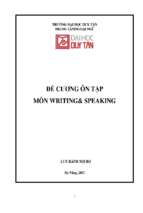Collins '
EAP
ectures
.
Learn listening and
note-taking skills
Fiona Aish and Jo Tomlinson
Academic Skills Series
Collins
HarperCo llins Publishers
77-85 Fulham Palace Road
Hammersmith
London W6 8JB
First edition 2013
Reprint 10 9 8 76 5 4 3 2 1 0
© HarperCollins Publishers 2013
ISBN 978-0-00-750712-2
Co llins® is a registered trademark of HarperCollins
Publish ers Limited
www.collinselt.com
:\ catalogue record for this book is availa ble from the
British Library
T\'pese t in India by Aptara
Primed in China by South China Printing Co . Ltd
.\ll rights reserved. No part of this book may be
;eproduced, stored in a retrieval system, or transmitted
1.. an~' fo rm or by any means, electronic, mechanical,
;:-ilOrocopying, recording or otherwise, without the prior
;:--ermission in writing of the Publisher. This book is sold
-..::"'ect to the conditions that it shall not, by way of trade
- cherw ise, be lent, re-sold, hired out or otherwise
~ -:..: la red without the Publisher's prior consent in any
. ;::-: oi bi nding or cover other than that in which it is
:- _:",;,hed and without a similar condition including this
_ -::17:on being imposed on the subsequent purchaser.
~]. -e,Collins
does not warrant that www.collinselt.com
- ,-, cher \yebsite mentioned in this title will be
.:e.: 'I1lmerrupted, that any website will be error
-~. --.i: '::e;ects \\'ill be corrected, or that the website or
-- ': _~- "~ ;:'--;Jt makes it available are free of viruses or
;' = -..:ll ~erms and conditions please refer to the site
::e': on the \\·ebs ite.
- --.b: Collins CO BUILD
-
.~
_!'':··a:l.::ed Dictionary.
The Publisher and author wish to thank th e following
rights holders for the use of copyright material:
Extract from Pursuit of Innovation lecture by Ammon
Salter http://wwwf.imperial.ac.uklimedia/content/
viewI1414/the-pursuit-of-innovation--1 0-march-20 III
reproduced by permission of Ammon Salter
Figure from Thurman, Harold v.; Trujillo, Alan P.,
Essentials of Oceanography, 7th Edition © 2002, p.240.
Reprinted by permission of Pears on Education, Inc.,
Upper Saddl e river, NJ
Photograph of Howard Gardener p141: ©2000 Getty
Images
If any copyright holders have been omitted , please contact
the Publisher who will make the necessary arrangements
at the first opportunity.
About the authors
Fiona Aish has taught, designed and managed English for Academic
Purposes courses at several universities and language schools in the UK.
Nowadays she works with postgraduate students on developing their
academic skills and dissertation writing.
Jo Tomlinson has worked at a number of universities and language
schools in the UK, teaching both general and academic English. She
currently delivers workshops and tutorials for postgraduate students on
academic skills and dissertation development.
Jo and Fiona are now directors of Target English Ltd, a company
specialising in teaching English for Academic Purposes and English for
exams. They have co-authored three books in the Collins English for
Exams Series: Listening for IELTS, Grammar for IELTS and Get Ready
for IELTS: Writing.
Acknowledgements
We would like to thank all our students and fellow teachers, in particular
Kate, Elisha, Inghar, Omar and Diego, who have been a great source of
information for the material in this book. Also, our thanks go to the team
at Collins ELT for their support and guidance.
We would like to dedicate the book to Andy Heywood and Margaret
Carvell.
HarperCollins and the authors would like to thank the following
contributors for kindly allowing us to record and use their lectures to
provide authentic listening practice: Dr Suzanne Hagan & Dr Uma
Shahani, Glasgow Caledonian University; Professor Bruce D. Malamud,
King's College London; Dr Joanna Royle, The University of Glasgow;
Professor Ammon Salter, Imperial College Business School; Jenny Siklos,
Madison English as a Second Language School.
~llcaledol1ial1
University
~
~
University
ifGlasgow
Imperial College
London
MESLS
i:':::'l::,t.::'.:.:.,
Contents
Introduction
6
Chapter 1
The purpose of lectures
• different types of listening
• what a lecture is
• what is expected from students
• the rhythm of English
• formal and informal language
8
Chapter 2
Preparing for lectures
• using course structure to prepare for lectures
• reading before a lecture
• understanding key vocabulary
• pausing and 'chunking' in speaking
• signposting
20
Authentic lecture 1: Bill Gates and philanthrocapitalism
30
Chapter 3
The structure of lectures
• understanding the structure of lectures
• differing lecture structures
• time expressions
• introductions and conclusions
34
Chapter 4
Features of speech
• noticing lecturers' accents and styles
• natural spoken language
• connected speech
• dealing with unknown words
• recording vocabulary
46
Authentic lecture 2: A brief overview of tsunamis
58
Chapter 5
Understanding points
• content of lecture notes
• lecturers' voice
• understanding fact and opinion
• reference words
62
Thinking critically
• analysing the lecturer's perspective
74
Chapter 6
A
C
C
A
Lt
GI
AI
AI
Contents
•
•
•
•
Authentic lecture 3: The pursuit of innovation
88
Chapter 7
Strategies for note taking
• different note-taking systems
• taking notes quickly
• relative clauses
• rising and falling intonation
92
Chapter 8
Understanding your notes
•
•
•
•
•
)
~
j
2
the importance of notes for assessments
rewriting notes
organizing paper and electronic notes
keeping notes accurate
using context to help with understanding
116
Chapter 9
120
Other types of academic listening
•
•
•
•
•
Chapter 10
listening in tutorials
listening in seminars
different university systems
pronunciation revision
polite language
Moving forward
130
know your strengths and weaknesses
making an improvement plan
speaker 'mistakes'
pronunciation review
Authentic lecture 5: Learner autonomy
140
Learner resources
144
Glossary
4
104
Authentic lecture 4: The history of universities in Western Europe
•
•
•
•
B
evaluating arguments and views in a lecture
applying critical thinking
connected speech and the 'schwa'
rhetorical questions
@ POWERED BY COBUILD
146
Audio scripts
148
Answer key
173
Introduction
Collins Academic Skills Series: Lectures will give you the skills you need to listen to and
understand lectures.
Designed to be used on a self-study basis to support English for Academic Purposes or study
skills courses, it is intended for students on pre-sessional or Foundation courses as well as
for first year undergraduate students. It will also be useful for more experienced students
who want to improve their library-based research skills.
The book has ten chapters covering the key skills for listening to lectures and taking notes.
There are also five authentic lectures to give you realistic practice. You will learn how to:
•
•
•
•
•
•
prepare for a lecture
recognise different lecture structures
follow the key points of a lecture
understand lecturers' accents and speaking styles
take notes and use them for assessments
evaluate your listening ability
At the back of the book there is:
•
•
a glossary of key terms
a comprehensive answer key
Chapter structure
Each chapter includes:
•
•
•
•
•
•
•
Aims - These set out the skills covered in the chapter.
A self-evaluation quiz - By doing this you are able identify what you already know on
the subject of the chapter and what you need to learn.
Information on academic expectations and guidelines on how to develop academic
skills - These sections will help you understand university practices and expectations so
you know what is required .
Practical exercises - These help you to develop the skills to succeed at university. You can
check your answers at the back of the book.
Tips - Key points are highlighted for easy reference and provide useful revision
summaries for the busy student.
Glossary - Difficult words are glossed in boxes next to where the text appears in the
chapter. There is also a comprehensive glossary at the back of the book.
Remember sections - This is a summary of key points for revision and easy reference.
•
•
•
c
a
Introduction
Authentic lectures
The book uses examples of authentic lectures in different academic subjects in the authentic
lectures chapters. The authentic lectures together with the accompanying exercises provide
supported practice of the academic listening skills needed to understand lectures at
university.
Glossary boxes
@ POWERED BY COBUILD
Where we feel that a word or phrase is difficult to understand, we have glossed this word/
phrase. All definitions provided in the glossary boxes have been taken from the COBUILD
Advanced Dictionary. At the end of the book there is a full alphabetical list of the most
difficult words from the book for your reference.
Using Lectures
You can either work through the chapters from Chapter 1 to Chapter 10 or you can choose
the chapters and topics that are most useful to you. The Contents page will help in your
selection.
Study tips
•
•
•
•
•
•
•
•
n
•
Each chapter will take between three and four hours depending on how many times
you listen to the audio scripts. Take regular breaks and do not try to study for too long.
Thirty to sixty minutes is a sensible study period.
Regular study is better than occasional intensive study.
Read the chapter through first to get an overview without doing any exercises. This will
help you see what you want to focus on.
Try the exercises before checking the Answer key. Be an active learner.
After doing the listening exercises in the book, you may want to do them again to try to
understand more of the content.
All university departments are different. Use the information in the book as a guide to
investigating your own university department.
Write questions you can ask to find out how your department delivers lectures, seminars
and tutorials.
There is no one correct way of listening to lectures and taking notes. Use your experience
of doing the exercises to learn what works best for you. Adapt the suggestions in this
book to suit your learning style and context.
Learning to listen to lectures and take notes is an on-going process, which means you
need to practise the same skills many times. Revise regularly.
Other titles
Also available in the Collins Academic Skills Series: Writing, Research, Numbers, Presenting,
and Group Work.
7
1
The purpose of lectures
Aims ./
./
./
recognize different types of listening
understand what a lecture is
know what is expected from you
./
./
I
recognize possible problems in lectures
understand the importance of attending
lectures
a
G
t:
Quiz
Self-evaluation
Read the statements below and circle the answers that are true for you.
:.... .. ........... ....... ........ .. ....... .. .... .. ...... .... ......................................................... ..... .......... ..... ... :....... .... ........ ...................... .. ..... ..................... :
,
: 1
I know who speaks in a lecture.
.
agree I disagree I not sure
:
: 2
I know how long a lecture usually is.
.
agree I disagree I not sure
~
1· ......................................................................................,............ ".................................. .....;.....................................................................~
j.............. ........ ............... ........ ................................. .......... ,............... ........ ...... ...... .... ........ .,.. ;....................... ............. .................. ....... .. .... ..;
I. ..~. . . ~. ~~.~~.~~~. ~t.~~.~~.~~.~.~..~~.. ~.e.c.~~.~.e.~.......................................................... :......~.~ ~~~ ...~ ...~i.~.~.~~~~... ~ ...~~.~..~.~~~.......:
: 4
I know what students are supposed to do in a lecture.
:
agree I disagree I not sure
: ................ ............ .. ......... ... .. .......... .. ........ ........ .. ........ .... ...... ......... .. ...................... . ............ :.... ........ .. ......... ...... .... ......... .... ...... .. ............... :
,
,
What types of listening do you do at university?
At university there are many situations where you will listen to different
speakers. Some of these situations will be academic, where you will listen
to your lecturers and tutors, some will be to find information about
university life, for example, from the university's accommodation staff
and some will be social, such as talking to other students in a cafe.
In some situations you will listen to one person speaking and in other
situations you will listen to a group of people speaking or discussing
something. You will also listen for different lengths of time and for
different reasons.
Th
11
DveI
Ti P ./
The tertiary education institution you go to after high school can be called different
names. In the USA, it is university, school and college. In the UK, it is university, or
' uni' and college. In South Africa, it is university, 'varsity', technikon, technical training
college or just institutes of further education and training. In Australia it is university
or 'uni' and TAFE (Technical And Further Education).
_-\n (
ofa
1
a
und(
desc
as a
1 The purpose of lectures
The different reasons for listening at university can be summarized as
follows:
intensive
Intensive
activity involves
concentrating a
lot of effort or
people on one
particular task in
order to try and
achieve a great
deal in a short
time.
o
CJ
., ,.
General listening: informal conversations, listening for specific
information in social situations, listening for advice from non-academic
university staff.
Academic listening: intensive listening for long periods of time to develop
your understanding of a topic, listening to explanations of assignments,
listening to topics being discussed in seminars, listening to your lecturers
in tutorials.
Exercise 1
Listen to the four extracts and write the order in which you hear the following
situations:
01
A
An informal conversation between students
C
A student asking staff for information
B
A lecture
D
A talk for students
What is a lecture?
A lecture is a talk given by a subject expert on a particular topic. The
subject expert is usually called a lecturer. A lecture often takes place in a
large room or lecture hall/theatre and is attended by a large number of
students, sometimes hundreds. The lecturer will talk about a particular
topic to all the students who will take notes. A lecture normally lasts
around 45 minutes to an hour.
1
The purpose of lectures
overview
An overview
of a situation
is a general
understanding or
description of it
as a whole.
Lectures are talks which give students a general overview of a topic. For
example, a lecture on the anatomy of the brain will give you general
information about the parts which make up the brain. Similarly, a talk on
marketing ethics will give you general information on what 'marketing
ethics' means along with information on current ideas on the topic. A
lecture is meant to be an overview. It is up to you to research the topic in
detail both before and after the lecture. The lecture is intended to give you
a starting point for further study.
I
9
Lectures
Tips
A lecture will give you:
./
./
./
./
Current, general academic opinions on a topic .
Key definitions, names, dates, theories and facts .
Ideas for further research and reading .
A starting point for your own thoughts.
How is a lecture different from other forms of speaking?
real time
If something
is done in real
time, there is
no noticeable
delay between
the action and
its effect or
consequence.
A lecture is a specific type of speaking and differs from other types of
speaking such as a conversation or a discussion. Below are some of the
features of a lecture.
1
The lecturer brings notes and usually has some form of visual
material (for example, a Power Point presentation) or handouts for
students. This means that the lecture will follow a structure and has
a more recognized order than a general conversation. The lecturer
knows what s/he wants to say and has thought about how to explain
it clearly. This is different from a conversation, where speakers think
and speak in 'real time'.
concentrate
If you
concentrate on
something you
give all your
attention to it.
The lecturer has prepared what s/he is going to say in advance.
2
The lecturer speaks for a long time.
In a lecture the lecturer usually speaks for an hour, sometimes longer.
This means that the listeners have to concentrate hard on one speaker
for a long period of time. This is not like conversations or discussions
where the speakers share the talking and listening time.
3
The students do not usually ask questions.
In conversation or discussion the speakers can interrupt each other
to ask questions, explain words, or give their own point of view.
In a lecture it is different; the students do not usually have the
opportunity to ask questions during the lecture except at the end.
Occasionally the lecturer will invite questions during the lecture, but
this is not always the case.
~
\
1 The purpose of lectures
o
()
'1 I'
02
Exercise 2
Listen to two lecturers speaking about lecturing, and complete the dialogue.
'Well, I've been 1 lecturing for about 40 years now, and it's changed a lot. I remember my
first lecture; it was me, the 2
and about 100 students. It was a bit of a scary
were introduced.
experience. I've seen lots of changes since then, mainly when 3
4
We started with
, where I would project slides so that the students could see
them, to PowerPoint presentations which everyone uses, and now finally to 5_ _ _ _ _ _ •
I'm a professor in philosophy, but sometimes I feel like a professor of technology!'
'I lecture in pharmacy at the local university. The 6
students. It's got a 7
the lecture interesting. I bring in
8
has room for about 60
at the front, but I don't like to use it. I always try to make
to help students make 9
• There
isn't time for 10
in the lectures. Lectures are more like ll
instead.'
students can always bring questions to their 12
,
but
III
k
-_.
er
IS
LIt
0
Exercise 3
Choose a word from your answers and match the word to its definition.
1
discussion
when people talk about something, often in order to reach a decision
2
a large flat, thin, rectangular piece of wood used for writing on
3
a paper containing a summary of a lecture
4
a regular meeting between a member of the teaching staff and one or
several students for discussion of a subject that is being studied
5
a large touch-sensitive screen connected to a computer and a digital
projector, used for teaching in the classroom
6
a high sloping desk for notes when giving a lecture
7
a flat vertical surface on which pictures or words are shown
8
a machine that has a light inside it and makes the writing or pictures
on a sheet or piece of plastic appear on a screen or wall
9
a room in a university or college where lectures are given
10
something you write down to remind yourself of something
11
a formal talk to show and explain an idea to an audience
11
Lectures
What is expected from you?
Your lecturers will expect you to do the following things.
Before the lecture:
ensure
To ensure
something, or
to ensure that
something
happens, means
to make certain
that something
happens.
•
Do some preparatory reading. This will give you some background
on the topic and make it easier to understand the lecture.
•
Find out what the lecture is about and look up some key words.
For more on preparing for lectures see Chapter 2.
preparatory
Preparatory
actions are done
before doing
something else
as a form of
preparation or as
introduction.
p
rI
.-\
During the lecture:
01
•
Take notes while the lecturer is speaking.
•
Do not talk to other students. Try to concentrate during the lecture.
After the lecture:
•
Do any follow up reading suggested by your lecturer.
•
Organize your notes and any handouts you are given. This will help
with essay writing and revision in the future.
Exercise 4
Imagine you are going to a lecture called 'The Future of Social Networking'. Look
at A-I below and decide if you should do them before, during or after the lecture.
A
Look up any unknown words from the lecture, or ask a friend .
S
Try to sit near the front and make notes. Don't expect to understand everything.
C
Try to listen to radio programmes on the subject.
o
Look up words on the topic of social networking and check their translations. If possible,
try to listen to the words so when you hear them you will be able to identify them.
E
Check through your notes and make sure you understand them.
F
Speak to other students about the topic before you go to the lecture, to familiarize yourself
with the subject.
G
Compare your notes with someone else who was at the lecture.
H Write down any important words that you don't understand.
Try to write down only the key points. Don't try to write everything down!
: : : ~~~~:~.:~~?::t~:::: . : : : : : ·: : : : :r~~r:l~~:t~~: l:e:c.:~r~:: : ": : : : : : :·: : : : : :i: ~~t~::t~~?::t~:::: : :.: : : : : :· . : : : :J
;n
1 The purpose of lectures
Ti p ./
You may be able to record lectures, but you must ask the lecturer's permission to do this.
Pronunciation: the rhythm of English
rhythm
A rhythm is a
regu lar series
of sounds or
movements .
Standard English is a stress-timed language, which means that the content
words (nouns, verbs, adjectives, adverbs) are usually spoken with more
emphasis or 'stress' by the speaker. In general the speaker does not stress
the other 'grammar' words. Below are some examples of unstressed
grammar words.
For example:
Modal verbs: may, might, can, could, will, would, must, should ...
Auxiliary verbs: is, are, was, were, have, had
J
Prepositions: in, at, to, for, etc.
Articles: a, the
Pronouns: I, he, she, it, they, etc.
<
Quantifiers: some, all, none, etc.
These two English sentences take approximately the same amount of time
to say.
1 Please wait here and the manager will see you in 5 minutes.
2
li you just wait here, the manager will be able to see you in
5 minutes .
The stressed words are in bold and the unstressed words are underlined.
13
1
Lectures
o
03
oo
Now listen to the examples.
Using stressed and unstressed words is very common with native speakers
of English but less common in people who use English as a second or
other language. These speakers tend to make less difference between
stressed and unstressed words compared to native speakers of English.
11
o
Exercise 5
Listen to the following sentences and mark the stressed and unstressed words
used by the speaker.
04
1
'Last week I went to a really interesting lecture on space but I didn't understand that
much of it because I hadn't prepared enough.'
2
'One of the most important aspects of university study which is totally different from
school is being able to manage the workload.'
3
'What I don't like about studying biology is having to write up the lab reports after
doing the experiments.'
4
'So, if you look at this slide, you'll notice how the concepts of philosophy as described by
the Enlightenment interact with our everyday lives, even in the 21 century.'
Sf
Tip ./
Remember that the rhythm of different speakers is unique so the rules of stress
in English are general. Stress patterns might differ according to the accent and
background of the lecturer.
For more on word stress and speaker intonation see Chapter 5.
The difficulty of lectures
attention span
Your attention
span is the
amount of time
that you can
concentrate on a
particular task,
activity, or subject
without becoming
distracted .
When English is not your first language, lectures can seem very
challenging, but you can develop techniques or strategies to help you
focus your listening. Firstly, you will need to be prepared to listen to the
lecturer talking for a long time, so you need to develop a good attention
span. Secondly, your lecturers will have different accents and some will
speak quickly, some slowly. Some of your lecturers will be easier to
understand than others. Remember that not every lecturer will be a good
speaker, some may repeat themselves, or speak too quietly, or be unclear.
Pc
1 The purpose of lectures
:rs
terminology
The terminology
of a subject is
the set of special
words and
expressions used
in connection
with it.
Also the terminology used in lectures will sometimes be unfamiliar. Often
very subject specific vocabulary is used and this means that some sections
may be easier to understand than others. Finally, it can be easy to lose the
path of the lecture and not understand how one part links to another. All
of these problems can be solved with careful planning.
For more on accents see Chapter 4.
Possible solutions to the difficulties of lectures
Cl
A
Exercise 6
Look at the solutions in the table and match them to the problems (A-D).
Problems with subject specific vocabulary.
C
Problems with losing the path of the lecture.
D Problems understanding sections of the lecture .
B Problems with general understanding.
................................................................................................................................................................................................................
............ :..S.?l~~i().~~ .............................................................................................................................................. :..~r.??~~~~............ :
1 : Record the lecture.
:
:
~ Swap notes with another student to check understanding .
~~~~.~~~~.~~l~.~~ ~.t~.~~~.~~.~~ ~~.~~~~.~ t~.~.~.e.r..~~.i~t.~ ~~.t.~~ l.~c.~~~.e.: ............................... :............................... :
............ :..
..
..
..
..
..
2 : Listen to long stretches of speech like the radio or online talks.
:
.
: Make sure you reposition yourself to keep focusing .
............!..s.~~. ~P .~~.r.~.~~~~:.................................................................................................................................... :...............................:
3
: Highlight in your notes where you have got lost or not understood, then
:
: complete these later with help.
:
:
............:..~~~~~?~.r ..t~.~~..Y.?ll.??I1?~..I1~~?t.? .~r.~t.~..~?~.I1 ..~.~~:.Y..~.?~?:...........................................
4 : Find out the lecture topic beforehand.
: '
!............................... :
: Find and translate the key terms.
e
.
............!. ~~a.?a..r?~?~..t~~.t.?pi~.?f..~~.~.. ~~~~~~~..?~~?r.~.y..?':.~().: ...........................................................:...............................!
n
)d
Lr.
15
1
Lectures
Formal and informal language in lectures
The type of language you hear in your lectures will vary depending on
subject and speaker, but there are some common features in the language
of lectures. Some features are associated with academic English (formal
features) and some features are more related to spoken English (informal
features). In your lectures, be prepared for a mix of both formal and
informal language features when listening to lectures.
Tips
.I
.I
Reading and writing in academic English tends to be formal.
Even in a formal lecture, language may be more informal because it is spoken.
Exercise 7
Read the definitions of language features in lectures and divide them into three
groups: 'formal', 'informal' and 'both'.
c:::::r~~~~~~i.~:::::::::::.:::::·::.::r:~~~i~i~~~?:::::::::: . :::::::·::::::.::::::::·:::::::::::r~~~~p'i~:.:::::::·::::::·:.::::::::::::::::r~~?~p:::::::::J
[1
: Signposting
: Words used to give indications of : firstly
~~~~.e ~~~.~~.e.e.c.~ .~.s ~~.i.~~
: '
~~ ?~h.~:.. u:.?~.4.s...................... ...:...... ....................:
:......... :........................................... :..
..
..
.................. :.. ..
: 2 : Noun phrases
: A group of nouns used together : the issue of stem cell
:
:
:......... :...........................................:..~?~~~.~..~. I.?~.~ .?~s.c.~~pt.i~~ ..I1?~~:....:..~.~~~~.~~~..:.::................................:.......................... :
:3
: Idioms
[ An expression which is familiar
[ to a group of people, but not
:
'I'd '£1 bl f
h
d
: easl Y I ent! a e rom t e war s
: within it.
: To go out on a limb
:
:(
h'
[
: to support somet mg
:
:
h
h. . h
: even t oug It mlg t put :
.
:......... :........................................... :..................................................................... :.X?~. I]! ..a.. ?I~~C.~!.t .P?SI.~~?.~) .. :.......................... :
:4
:
: Phrasal verbs
: A two part verb that is made up [ find out (to discover)
[ of a verb + preposition or verb + :
[
:
.
:......... :........................................... :..a.?~e.:.?: ..................................................... :............................................ ,.......... :..........................:
: 5 : Passive
: A structure which focuses on the [ The evidence was tested :
:
: object of an action and not the
: in four countries.
: constructions
:.........:.................................... ....... :. ~.~?J.~.c.~:................................. ....................:................. ...................................... :..... .....................:
:6
: Hedging
[ Words which make a statement
[ less direct for example, modal
: There may be several
: possible reasons for the
:
:
.
:.........:........................................... :..::~:.? ~? ~.~ ~.~.r!?~.'..~?j.~c.t.iv.~?~.~t.c............:..~·~~t:!.~~s:........................................:.......................... :
: 7 : Reporting verbs
: Verbs which report the words of : A group of academics at :
:
: Exeter University assert [
:
:
[
: people.
.
:
'
[ that the results need
.,........ :...........................................:..................................................................... :.!u.~!?~.r..~,:.a.~y'~~~: ...................... :.......................... :
16
r.o
1 The purpose of lectures
ge
l
o
0.
Exercise 8
Listen to the lecture on negotiation techniques and complete the examples of
features mentioned in Exercise 7.
05
al
1
F
2
It c
3
E
4
The k
to great negotiation
5
The r
w
6
At
7
Thei
choices the other p
8
Asw
as
9
Let's I
10
o
of a
be s
up
-w
in negotiation
street
is making
to
B
up
Exercise 9
Now label the phrases in Exercise 8 with the features in Exercise 7.
For example: 1 First of all = signposting
Ti ps
.I
.I
Reading and writing in academic English tends to be formal.
Even in a formal lecture, language may be more informal because it is spoken. Things
like phrasal verbs and idiomatic language are often used in spoken English, even in
lectures .
117
Lectures
o
f
Exercise 10
Look at the following lecture extracts and decide which lecturer uses more
formal language and which uses more informal language.
A
We shall begin with an overview of traditional reporting tools used by French newspapers
today, and assess whether these tools could be adapted for other countries. Then we will
consider how globalization has affected all such reporting methods.
B
We will start with looking at traditional reporting tools used by French newspapers at the
moment, and assess whether these tools would work out in other markets. Then we'll look
at how globalization has had a knock-on effect on all these kinds of reporting methods.
Why attend lectures?
There are many reasons to attend lectures at university. Going to lectures
will help you learn new information about your subject area, get ideas
for writing assignments, or just give you the opportunity to meet up with
other students on your course. However, the main reasons for going to
lectures can be divided into two main areas.
o
Exercise 11
Look at the list of reasons for going to lectures. Decide which relate to understanding
your course content and which relate to personal study and assessment.
1
You may get some ideas to help you with your essays, exams and presentations.
2
You can find out about how the topic of the lecture relates to the other topics or
modules on your course.
3
You will see how the topic is currently understood by academics in your university and
other universities around the world.
4
Your lecturer will focus on the important areas of the topic so you don't waste your time
researching unimportant aspects afterwards.
5
You learn about how the topic has developed over time through academic research.
6
Your lecturer may give you suggestions for reading to help you develop your
understanding of the lecture topic .
..... ... .. ......................... .. .. ............. ......... ...... .... .. ............. .......... : .. ..... ...... .......... ........... .............. ..... .... .. ... ...... ........... ................. :
Understanding your course content
: Helping with your assignments and
................................................................................................ :..~~.s.e.~~~~~~~........................................................................ ,
... ... .. .............................. ............. ... ..... .... ......... .. .. .. ................. .:............. ..... ... ..... .... ....... .. ....... .. ......... .. ................... ... ............... :
1 The purpose of lectures
Remember
./
A lecture is a specific form of listening; you need to listen, take notes,
and keep focused. You cannot usually ask questions.
./
./
The lecturer may use a mix of formal and informal language .
./
You will be expected to have done some preparatory work, keep
good notes and do some follow-up reading.
./
You may be able to record your lectures, but make sure you have
permlSSlOn.
You may hear many different lecturers. They may use different
intonation to what you are used to. Try to become familiar with this.
res
ith
19
19
1
- Xem thêm -

